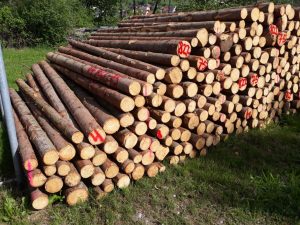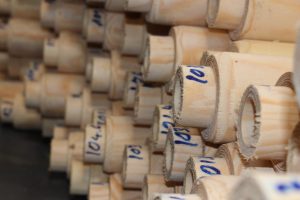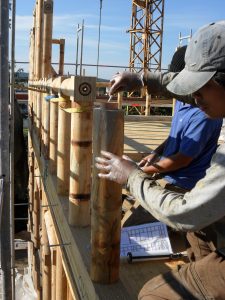BAMBUTEC describes a systematic process to create efficient solutions with high performing joints in structural trusses.

Bambutec prefabs: Milled bamboo-poles and wooden, cnc-shaped jointing-elements.
The core of the patented technology is a universal jointing method using natural poles in milled, peeled or even raw shapes. Each connection bares an incredible high stress in torque, compression and tensile force.
Structural girder and space frame constructions are representing the practical implementation of the most efficient mechanical principle in civil engineering. These structures are identified by coaxial connected rods in always one dedicated intersection. In the present state of art, it is not possible to join consistently several timber- or bamboo-poles in only precisely one node by performing and conducting torque, forces of tensile as well as compression. BAMBUTEC achieves this in consequently using jointing-elements which do not have the natural longitudinal texture of timber. The timber poles are precisely machined to fit coaxial into the jointing elements being made from wood composite or multilayer ply, providing the necessary multidimensional mechanical properties.
This unique characteristics of this technology allows to statically analyze structural trusses made of timber-poles, just like it is in such steel structures. The natural properties of timber and bamboo leads to an exceptional stiff response of such structures under load at very light weight. These are characteristics to recommend the use of BAMBUTEC in a wide field of engineering, such as construction in earthquake prone areas as well as under various other disastrous conditions.
Learn more about the unique advantages, that BAMBUTEC provides in the following paragraphs.
Sourcing raw materials

Regular stack of wood delivered directly from forestry
The basic resource in BAMBUTEC constructions are natural timber poles, or instead of timber, bamboo poles. Hence the major demand for material in BAMBUTEC constructions is sourced directly from local forestry. This straight way of sourcing assures the economic and sustainable character of the technology. Especially small sized round wood is available in large quantities at low prices. Starting at a diameter of only 90mm in raw condition, the material can be used for high performing frameworks, without any compromises in quality. In a global context, wherever there is a lack of timber, other natural poles such as bamboo can be used. Bambutec provides solution to integrate even conventional problematic raw materials into accountable, high performing frameworks for even earthquake-proof construction.
Ecology and sustainability

Bambutec-skeleton of a residential building
Taking ecology into account, the focus points on global warming. Bambutec helps to avoid greenhouse gas in double-acting: First, the timer structure itself represents a lot of previously bound carbon dioxide, which otherwise would be present in the atmosphere. Second the usage of steel or aluminium is responsible for an enormous amount of emissions, which could be avoided by using renewable resources such as timer and bamboo. The amount of bound CO2 versus the amount of produced CO2 during manufacturing of different building-materials is demonstrated in the chart below.
Economy and longevity

Model of possible construction method using Bambutec: Wooden skeleton, clay fillings, reed insulation, three coat lime plaster
Past and present projects show that the economical efficiency gained by 20 to 40%, compared with conventional methods in building structural trusses. The systematic character of BAMBUTEC supports any extension of existing structures while maintaining its simplicity and efficiency.
The durability of Bambutec-structures is highly scalable, depending on the kind of wood and diameter being used. The longevity depends on the protection and preservation of the structure – especially regarding moisture and parasites. Taking appropriate measures, like protection by design (=i.e. roof), the lifetime is actually unlimited.
Design & planning

Structure planning of residential building.
The initial step of the systematic process in production must be a careful design and scheduling. A geometrical precise drawing is compulsive and provided in the course of CAD-modeling. Bambutec has developed dedicated tools to significantly simplify the design process, automatically including all relevant data for production.
The simple wire frame as a basic geometry is very easy to make, but already defines the important parameters of a structure. The static analyzing software is using the wireframe as input to statically check the structure, enabling improvements at an early stage.
The form and looks of a building after that is now completed by including the joints and rods in real dimensions as solids, followed by cladding, roofing, windows, doors, etc…
Production

Machined wooden poles, ready for assembly
The poles get special round-shaped “male” connections on both ends, which fit precisely into the complementary machined jointing elements. This way a big correlated surface for bonding is provided, exactly which results in the extreme strength and stiffness of Bambutec connections. By machining both connections per rod simultaneously in one step, exact coaxial alignment of the connections is assured. That is why even naturally imperfect shaped poles or “buckling logs” can be used for technical structures, leading to precise geometrical results.
As of today our German production implements state of the art technology, making fully automated CNC production of joint-elements possible. The conventional production method though enables an incredible portability of the technology, allowing to work around the globe with even completely untrained and unexperienced personnel. The first step in the conventional production of joint-elements is pasting the joint-element-plot onto the raw material, then cutting out the outline. After that, each connection is milled in the manual BT-joint-milling-machine, in exact alignment to the pasted plot, provided by the initial CAD-design.
Today we work with production tolerances below 0.5 millimeter.
Assembly

Residential building structure assembly
Finally the connection becomes firm by applying adhesive. The resin is been dispensed to the grooves of the correlated fittings. Special tools are used to spread the adhesive to a uniform film on all surfaces. The exact tolerance inside the connections assure precise contact with glue in all correlated surfaces. The exact tolerance between the fittings assure precise contact with glue in all correlated surfaces like shell and frontal area.The rating under tensile load takes the shell surface of all grooves only. The adhesive used by Bambutec are certified according to EN-standards. Otherwise with very good results, even natural adhesives like casein is applicable.
During curing process each joint and pole is kept in position with a centrical tight fitted wood or metal pin, which also increases angular accuracy. After curing time, typically 8 to 24 hour, depending on environmental conditions, the structure is fully durable.



